ABOUT ADAP
The AIDS Drug Assistance Program (ADAP) provides medications for the treatment of HIV disease. Program funds may also be used to purchase health insurance for eligible clients. Amendments to the Ryan White CARE Act in October 2000 added additional language allowing ADAP funds to be used to pay for services that enhance access, adherence, and monitoring of drug treatments. The program is funded through Title II of the CARE Act, which provides grants to States and Territories.
Funding
ADAP grants are awarded to all 50 States, the District of Columbia, American Samoa, Puerto Rico, Guam, North Mariana Islands, and the U.S. Virgin Islands.
Congress “earmarks” funds that must be used for the ADAP, an important distinction since other Title II spending decisions are made locally. The ADAP “earmark” is by far the fastest growing component of CARE Act appropriations. State ADAPs also receive money from their respective States, other CARE Act programs, and through cost-savings strategies.
A formula based on AIDS prevalence is used to award ADAP funds to States and Territories. However, three percent of the total “earmark” is reserved for supplemental grants to States and Territories with demonstrated severe need that prevents them from providing medications consistent with Public Health Service Guidelines to clients.
Clients
ADAP clients do not have adequate health insurance or the financial resources necessary to cover the cost of medications.
Many clients are enrolled in ADAP only temporarily while they await acceptance into other insurance programs, like Medicaid.
Implementation
The ADAP in each State and Territory is unique in that it decides which medications will be included in its formulary, and how those medications will be distributed.
Many States and Territories provide medications through a pharmacy reimbursement model. Patients show enrollment cards at participating pharmacies to receive their medications, and the pharmacy invoices the ADAP for payment.
Some ADAPs use pharmacies located within public health clinics to distribute drugs.
A few ADAPs purchase drugs and mail them to clients directly.
Eligibility
Each State and Territory establishes its own eligibility criteria. All require that individuals document their HIV status. Nine programs require a CD4 count of 500 or less. Fifteen States have established income eligibility at 200 percent or less of the Federal Poverty Level (FPL). Nationally, more than 80 percent of ADAP clients have incomes at 200 percent or less of the FPL.
Increasing Demand
Pressure on ADAP resources has increased substantially.
Highly Active Antiretroviral Therapy (HAART) is the standard of care for the majority of individuals living with HIV disease. Its cost may be $12,000 per year or more, in addition to the costs of addressing opportunistic infections, side affects, and other treatment issues.
AIDS mortality has decreased dramatically in the United States since 1995, and HIV incidence remains constant at approximately 40,000 new infections annually. Therefore, the total number of individuals living with HIV disease continues to climb.
The epidemic is growing rapidly among minorities, who have historically experienced higher risk for poverty, lack of health insurance, co-morbidity, and disenfranchisement from the health care system. The result is a growing number of individuals living with HIV disease who require public support.
*SOURCE: Health Resources & Services Administration (HRSA).


